Radiacja ewolucyjna
Radiacja ewolucyjna – proces polegający na zwiększaniu się taksonomicznej różnorodności i morfologicznego zróżnicowania z powodu adaptacji do zmian lub zajmowania nowych ekoprzestrzeni[1]. Radiacje ewolucyjne mogą wpływać na jeden klad lub wiele, mogą być gwałtowne lub stopniowe – gdy są gwałtowne i występują w jednej linii ewolucyjnej jako przystosowanie do środowiska, nazywane są radiacją adaptacyjną[2].
Przypisy
- ↑ Gina D. Wesley-Hunt. The morphological diversification of carnivores in North America. „Palaeobiology”. 31 (1), s. 35–55, 2005. DOI: 10.1666/0094-8373(2005)031%3C0035:TMDOCI%3E2.0.CO;2 (ang.).
- ↑ Dolph Schluter: The Ecology of Adaptive Radiation. Oxford: Oxford University Press, 2000. ISBN 978-0-19-850523-5.
| ||||||||||||||||||||||||||
Media użyte na tej stronie
Darwin's finches or Galapagos finches. Darwin, 1845. Journal of researches into the natural history and geology of the countries visited during the voyage of H.M.S. Beagle round the world, under the Command of Capt. Fitz Roy, R.N. 2d edition.
- 1. (category) Geospiza magnirostris
- 2. (category) Geospiza fortis
- 3. Geospiza parvula, now (category) Camarhynchus parvulus
- 4. (category) Certhidea olivacea

